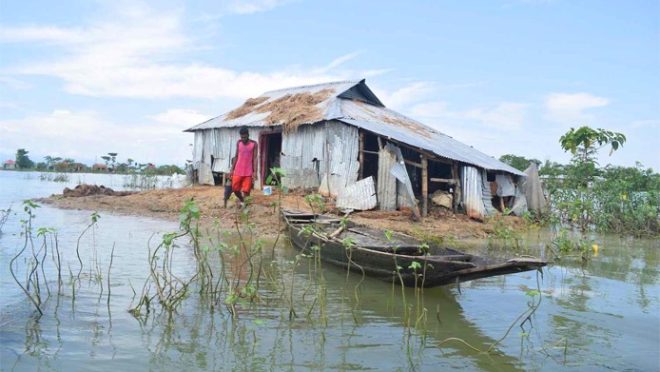Against the tides: A haor farmer's struggle with climate change
Against the tides: A haor farmer's struggle with climate change

Haors, large bowl-shaped depressions and seasonal wetlands, are mostly located in the northeastern part of Bangladesh. These seasonal wetlands remain full of water from July to September, coinciding with monsoon. Thereafter, the water starts receding, gradually reducing the size of the haors.
A 55-year-old farmer, Joynal Mia, who lives in the Itna Haor of Kishoreganj, is facing many challenges during cultivation. His sufferings represent those of other farmers in the region.
Standing knee-deep in the fertile mud of his Haor plot, Joynal Mia surveys his land with a worried frown. The once-vibrant expanse of green paddy shoots now resembles a patchy mosaic, the telltale signs of recent flash floods. “This would be shoulder-high Boro rice by this time [in previous years],” laments Joynal, his weathered hands clutching a wilting stalk. “But the Afal [flash floods] came early this year, taking half my crop with it.”
Reduced cultivation windows, down from 30 days a decade ago to a mere 15-20 today, coupled with water scarcity stretching from February to March and sometimes even May, leave little room for error. Every season is a gamble.
Rising temperatures, including recent heatwaves, have further strained crop growth, reduced yields, and stressed livestock. Joynal’s fields have been severely damaged by these heat waves, leading to substantial crop losses and economic strain. Early monsoons and flash floods frequently damage rice crops, Joynal’s primary source of income.
Flash floods (Afal) erode the soil, shrinking the cultivable land area. The unpredictable seasons and early rains disrupt harvest schedules, leading to potential crop losses and increased harvesting costs. During peak monsoon months, water overflows disrupt cultivation and harvesting, leading to significant crop losses—sometimes as high as 95%.
Rising riverbeds and climatic hazards have contributed to an increase in flood height from 3-5 feet to 5-10 feet, causing more damage. Regular floods, hailstorms, pests, and heatwaves have significantly reduced crop yields, further complicating Joynal’s farming efforts.
The monsoon season not only affects farming but also disrupts daily life. Joynal’s children often cannot go to school during heavy monsoons, hampering their education and future prospects.
Joynal and his family aren’t alone in this struggle. Many farmers are forced to take on debt to survive, trapped in a cycle of financial insecurity. The lack of access to climate-resilient crops and limited infrastructure further compounds their challenges. A glimmer of hope flickers in Joynal’s eyes.
“We’re trying to adapt,” he says adding, “The government has introduced some training programmes, and we’re looking at new, flood-resistant rice varieties.”
However, the road ahead is long and filled with uncertainty.
Joynal Mia’s story is not unique. He represents the countless farmers of the Haor areas, their resilience tested by a changing climate. Their struggle is a stark reminder of the human cost of climate change and the urgent need for collective action to protect their livelihoods and ensure a food-secure future for generations to come.
Muhammad Mustakim Billah is doing his Masters in Soil Science at the Bangabandhu Sheikh Mujibur Rahman Agricultural University.


